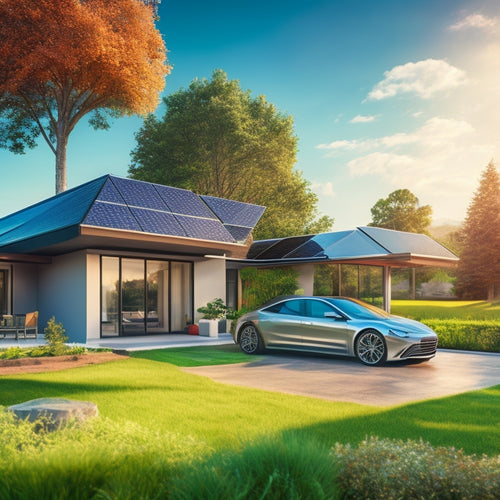
Designing for Maximum Efficiency in Commercial Solar Power
Share
When designing a commercial solar power system, you'll want to prioritize maximum efficiency to optimize energy production, reduce costs, and guarantee a strong return on investment. You'll need to assess your site's conditions and constraints, including topography, shading, and weather patterns, to determine the ideal panel orientation and tilt. Selecting high-efficiency solar panels with advanced cell technologies will also enhance energy output. By minimizing energy losses, implementing energy storage solutions, and establishing effective monitoring and maintenance strategies, you'll be able to maximize your system's efficiency. Now, take the next step in optimizing your commercial solar power system.
Key Takeaways
- Conduct thorough site assessments to identify optimal solar panel orientation, tilt, and placement for maximum energy production.
- Select high-efficiency solar panels (>20% efficiency rating) and consider advanced cell technologies like bifacial and PERC cells.
- Implement energy loss minimization strategies, including energy audits, load balancing, and waste reduction measures to optimize energy production.
- Utilize energy storage systems and optimize energy usage to enhance efficiency and increase ROI through strategic storage solutions.
- Establish real-time performance tracking, scheduled maintenance, and maintenance documentation to ensure peak system performance and regulatory compliance.
Assessing Site Conditions and Constraints
Designing for Maximum Efficiency in Commercial Solar Power
Assessing Site Conditions and Constraints
Optimizing commercial solar power systems requires a significant comprehension of the site conditions and constraints that can impact energy production. You need to evaluate the site topography, considering factors like terrain slope, aspect, and elevation. This helps identify potential issues with drainage, access, and maintenance.
A thorough shading analysis is also essential, as it reveals areas where trees, buildings, or other obstructions may cast shadows on your solar panels. This information enables you to design a system that minimizes energy losses due to shading.
Additionally, you should assess local weather patterns, including temperature, precipitation, and humidity, to determine their impact on system performance. By understanding these site conditions and constraints, you can design a commercial solar power system that operates at maximum efficiency, generating the most energy possible from your investment.
Optimizing Panel Orientation and Tilt
Your solar panel array's orientation and tilt play an essential role in utilizing the maximum amount of energy from the sun. To enhance energy production, you'll want to carefully consider these factors during the design phase.
Ideally, your panels should face directly at the sun, but since the sun's position changes throughout the day and year, you'll need to find a balance.
Panel tracking systems can help you achieve this balance by adjusting the panel's angle and orientation in real-time. However, if you're looking for a more cost-effective solution, you can make seasonal adjustments to your panel's tilt to account for the changing sun angle.
It's also essential to conduct a shading analysis to identify any potential obstructions, such as trees or buildings, that could impact energy production.
When determining the best orientation and tilt for your panels, you should consider your local climate and the time of year when energy production is most critical.
Selecting High-Efficiency Solar Panels
When selecting high-efficiency solar panels, you'll want to take into account panel efficiency ratings, which measure the percentage of sunlight converted to electricity.
Look for panels with high efficiency ratings, typically above 20%, to maximize energy production.
Advanced cell technology, such as bifacial or PERC cells, can also enhance efficiency by increasing energy output per unit area.
Panel Efficiency Ratings
Between module efficiency, temperature coefficient, and other performance metrics, selecting high-efficiency solar panels can be a challenging task, especially considering the numerous options available in the market.
As you traverse this intricate environment, it's crucial to understand the panel efficiency ratings that matter most.
When evaluating panel efficiency, you'll want to focus on the following key metrics:
-
Peak Efficiency: The maximum efficiency rating under ideal laboratory conditions, typically measured at 25°C and 1,000 W/m² irradiance.
-
Nominal Operating Cell Temperature (NOCT): The temperature at which the panel operates under real-world conditions, influencing its overall efficiency.
-
Temperature Coefficient: The percentage decrease in efficiency per degree Celsius increase in temperature, affecting panel performance in varying climates.
Advanced Cell Technology
The pursuit of maximum efficiency in commercial solar power systems leads to the forefront of advanced cell technology, where high-efficiency solar panels are designed to excel.
As you investigate the latest innovations, you'll find that perovskite cells, bifacial technology, and multi-junction cells are pushing the boundaries of solar cell efficiency. Thin film innovations have also made notable progress, allowing for more efficient energy harvesting.
Nanotechnology applications have further enhanced performance, enabling the creation of high-efficiency solar cells.
When selecting high-efficiency solar panels, you'll want to reflect on organic photovoltaics, tandem solar cells, and quantum dot technology. These state-of-the-art solutions can greatly enhance your system's performance.
Additionally, recycling solar panels has become a vital aspect of sustainable solar power, ensuring that materials are reused and waste is minimized.
Minimizing Energy Losses and Waste
By optimizing system design and component selection, you can markedly reduce energy losses and waste in commercial solar power installations. This requires a thorough approach that considers every aspect of the system, from thermal management to grid integration.
To achieve maximum efficiency, focus on the following key areas:
-
Energy Auditing and Waste Reduction: Conduct thorough energy audits to identify areas of inefficiency and implement measures to reduce waste. This includes optimizing system design, component selection, and ongoing monitoring and maintenance.
-
System Design and Load Balancing: Confirm that your system is designed to balance load demands and optimize energy production. This involves careful planning and simulation to confirm that the system operates at maximum efficiency.
-
Regulatory Compliance and Financing Options: Verify that your system meets all relevant regulatory requirements and take advantage of available financing options to minimize upfront costs and maximize returns on investment.
Implementing Energy Storage Solutions
As you move to maximize the efficiency of your commercial solar power installation, implementing energy storage solutions becomes an essential step.
This allows you to optimize your energy usage, reduce waste, and increase your return on investment. Energy storage solutions, such as batteries, enable you to store excess energy generated during the day for use during periods of high demand or when the grid is unavailable.
Effective battery management is critical to guarantee the longevity and performance of your energy storage system.
Monitoring and Maintenance Strategies
You'll want to implement real-time performance tracking to identify potential issues before they impact your system's efficiency.
This involves installing monitoring systems that provide instantaneous data on your solar power system's performance, allowing you to respond quickly to any anomalies.
Real-time Performance Tracking
At least 95% of a commercial solar power system's overall efficiency hinges on its ability to perform ideally in real-time. You need a system that can monitor and track performance in real-time to guarantee maximum energy production. This is where real-time performance tracking comes in.
With real-time performance tracking, you can:
-
Identify performance issues instantly: Receive alerts and notifications when there's a deviation from peak performance, allowing you to take prompt corrective action.
-
Analyze performance data: Employ data visualization and performance analytics to gain understanding into your system's operation, identifying areas for improvement and opportunities for enhancement.
-
Enhance energy production: Adjust your system's settings and configuration in real-time to maximize energy output, making certain you get the most out of your investment.
Scheduled Maintenance Schedules
By integrating scheduled maintenance schedules into your commercial solar power system, you guarantee peak performance and maximize energy output over its lifespan.
Preventive maintenance is key to guaranteeing your system operates at ideal levels, and scheduled inspections help identify potential issues before they become major problems.
Regular maintenance best practices, such as cleaning panels and inspecting electrical connections, can extend equipment longevity and reduce downtime.
To make certain your maintenance team is equipped to handle tasks efficiently, invest in maintenance training and establish clear safety protocols.
Service contracts with reputable providers can provide additional support and peace of mind.
Accurate maintenance documentation is also essential for tracking maintenance history, identifying trends, and planning future maintenance activities.
Integrating With Existing Infrastructure
Most commercial solar power systems are installed alongside existing electrical infrastructure, and integrating the two efficiently is crucial for maximizing energy production.
You'll need to contemplate how the solar power system will interact with the existing infrastructure, guaranteeing seamless integration and minimizing disruptions to your operations.
To achieve this, you should:
-
Assess grid compatibility: Verify the solar power system meets the electrical grid's technical requirements, including voltage, frequency, and power quality standards.
-
Plan for structural modifications: Identify necessary modifications to your building's structure or electrical system to accommodate the solar power system, such as installing new electrical panels or reinforcing roofs to support the weight of solar panels.
-
Evaluate financing options and regulatory considerations: Investigate available financing options, such as tax credits or grants, and ascertain compliance with relevant regulations, including building codes and zoning laws.
Frequently Asked Questions
Can Commercial Solar Power Systems Be Installed on Rooftops With Skylights?
When considering rooftop installation, you'll need to assess skylight considerations, ensuring that commercial solar power systems are installed around or integrated with skylights to maintain natural lighting while utilizing renewable energy.
How Does Solar Panel Cleaning Impact Overall System Efficiency?
You're like a skilled chef, ensuring every ingredient is perfect; similarly, you must prioritize solar panel cleaning, an essential aspect of solar panel maintenance, using ideal cleaning techniques to maximize energy output and prevent efficiency losses.
Are There Any Incentives for Businesses to Adopt Solar Power?
You can benefit from tax credits and renewable energy grants, which offset installation costs, making solar power a more viable option for your business, and contributing to a sustainable future you can be proud to be a part of.
Can Solar Power Systems Be Designed for Disaster Relief and Backup Power?
Slim DESC McKin Slim
Are Commercial Solar Power Systems Compatible With Electric Vehicle Charging Stations?
You'll find that commercial solar power systems seamlessly integrate with electric vehicle charging stations, leveraging battery storage to optimize energy distribution and utilizing existing charging infrastructure for a streamlined, efficient experience.
Conclusion
As you've optimized your commercial solar power system, think of it like a finely-tuned machine, where every component hums in harmony to maximize energy output. Just as a skilled conductor expertly balances each instrument to create a concert, you've orchestrated panel orientation, high-efficiency panels, and energy storage to minimize losses and waste. The result? A system that produces a sweet melody of efficiency, like the 25% increase in energy production achieved by a California-based solar farm after implementing similar design strategies.
Related Posts
-

What Solar Panels Work Best With EVS Online?
When shopping for solar panels online to power your electric vehicle, look for high-efficiency models that can withst...
-

Charging Points in Rural Areas: 5 Key Insights
When driving through rural areas, you'll face a shortage of charging points, making EV ownership stressful and inconv...
-

Eco-Friendly Car Battery Solutions Available Online
You can now shop online for eco-friendly car battery solutions that not only reduce your carbon footprint but also of...


